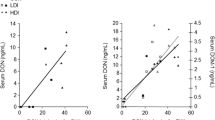Abstract
Wheat infected naturally withFusarium, contaminated mainly with 18.53 mg DON per kg, was added to a total constant wheat proportion of 400g/kg diet. Control and DON contaminated feed was fed for 11 weeks underad libitum and restrictive feeding conditions to 48 pigs of both sexes, which were randomly divided into 4 groups. Effects on performance (live weight range between 26 and 100kg), duration of feed intake and blood parameters were investigated. Parallel to this study, a balance study was carried out to examine the effects on nutrient digestibility and DON metabolism.
The group fed the DON contaminated rationad libitum consumed 15% less feed and gained 14% less live weight compared to thead libitum control group, while the feed to gain ratio was unaffected. Under restrictive feeding conditions (DON and control) pigs exhibited 33%, 25% and 10% lower feed consumption, live weight gain and feed to gain ratio, respectively, than the control group fedad libitum. Metabolizability of energy, digestibility of organic matter, crude protein, crude fat and N-retention were significantly increased by 4, 3, 6, 11 and 10%, respectively, in the DON group of the restrictively fed pigs.
In average up to 43.2% of the ingested DON, as the parent toxin in both groups, was eliminated with the urine and up to 3.0% with faeces. DON fed animals needed more time to consume the restrictive ration than the control group.
Similar content being viewed by others

References
Bondy GS, Pestka JJ (2000) Immunomodulation by fungal toxins. J Toxicol Environ Health B Crit Rev 3: 109–143
Dänicke S, Valenta H, Döll S, Ganter M, Flachowsky G (2004a) On the effectivenes of a detoxifying agent in preventing fusariotoxicosis in fattening pigs. Anim Feed Sci Technol 114: 141–157
Dänicke S, Valenta H, Klobasa F, Döll S, Ganter M, Flachowsky G (2004b) Effects of graded levels of Fusarium toxin contaminated wheat in diets for fattening pigs on growth performance, nutrient digestibility, deoxynivalenol balance and clinical serum characteristics. Arch Anim Nutr 58: 1–17
Dänicke S, Goyarts T, Valenta H, Razzazi E, Böhm J (2004c) On the effects of increasing deoxynivalenol (DON) concentrations in pig feed on growth performance, utilization of nutrients and metabolism of DON. Arch Anim Nutr, in press
Eriksen GS, Pettersson H, Johnsen K, Lindberg JE (2002) Transformation of trichothecenes in ileal digesta and faeces from pigs. Arch Anim Nutr 56: 263–274
Swamy HV, Smith TK, MacDonald EJ, Boermans HJ, Squires EJ (2002) Effects of feeding a blend of grains naturally contaminated with Fusarium mycotoxins on swine performance, brain regional neurochemistry, and serum chemistry and the efficacy of a polymeric glucomannan mycotoxin adsorbent. J Anim Sci 80: 3257–3267
Valenta H, Dänicke S, Döll S (2003) Analysis of deoxynivalenol and de-epoxy-deoxynivalenol in animal tissues by liquid chromatography after clean-up with an immunoaffinity column. Mycotoxin Research 19 (1): 51–55
Author information
Authors and Affiliations
Corresponding author
Additional information
Financial support Deutsone Forschungsgemeingschaft
Rights and permissions
About this article
Cite this article
Goyarts, T., Dänicke, S. Effects of deoxynivalenol (DON) on growth performance, nutrient digestibility and DON metabolism in pigs. Mycotox Res 21, 139–142 (2005). https://doi.org/10.1007/BF02954439
Issue Date:
DOI: https://doi.org/10.1007/BF02954439


